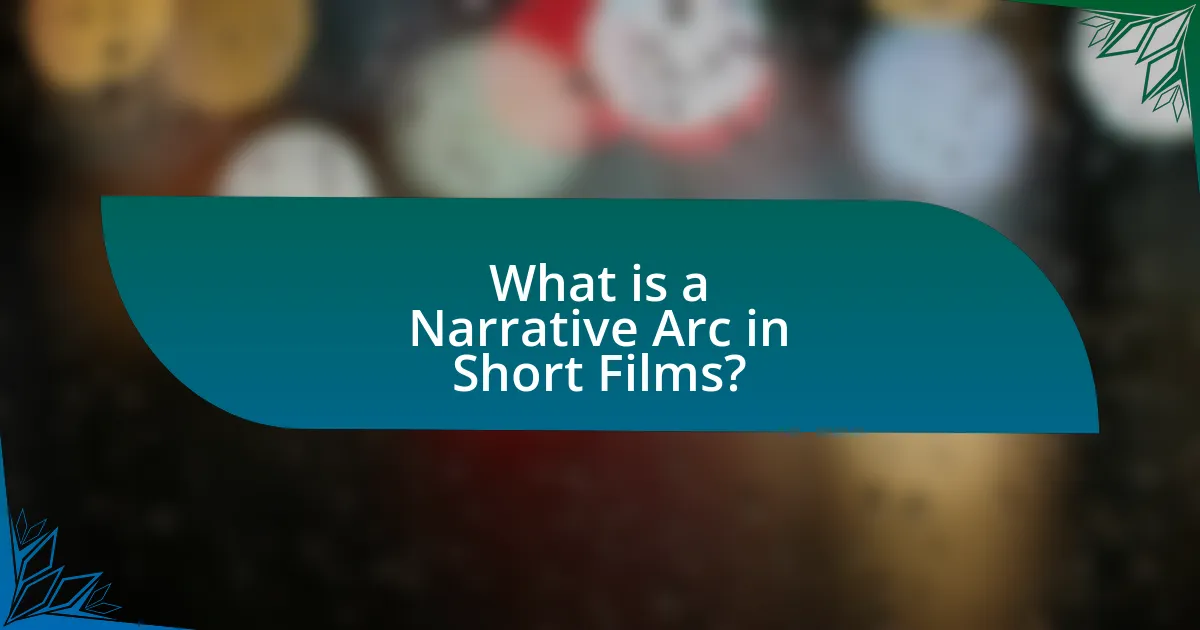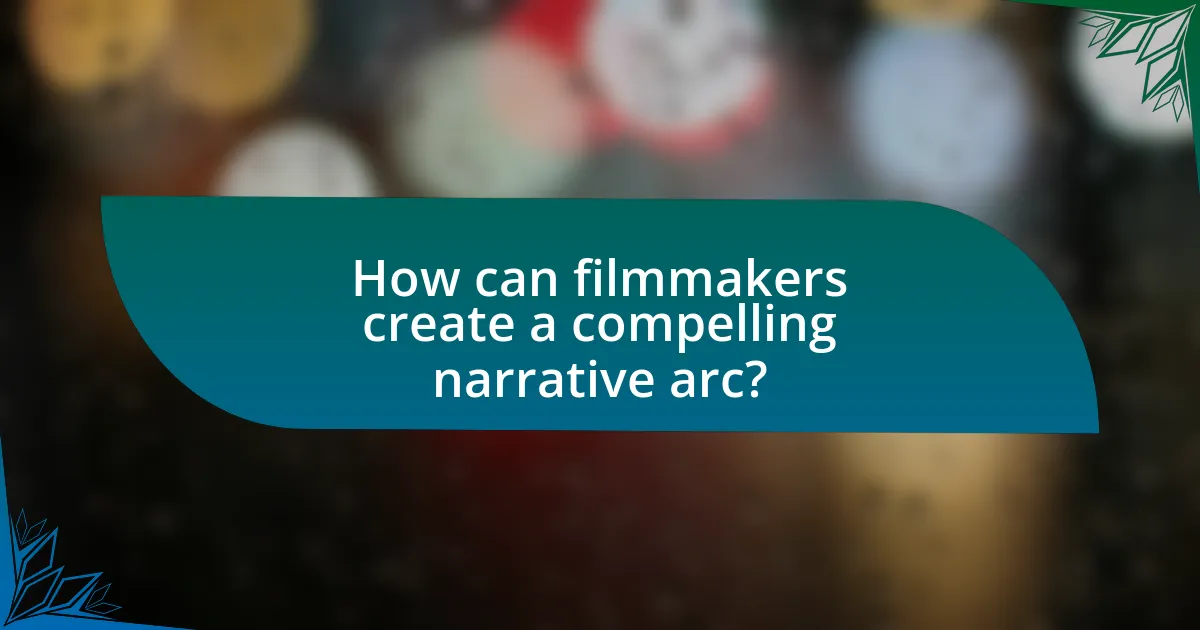The article focuses on creating a compelling narrative arc in short films, emphasizing the structured framework that includes exposition, rising action, climax, falling action, and resolution. It highlights the differences between narrative arcs in short films and feature films, noting the importance of concise storytelling and character development within a limited runtime. Key elements such as conflict, pacing, and character arcs are discussed, along with practical tips for filmmakers to enhance their narratives. The article also examines common pitfalls to avoid, the significance of various genres, and the role of storyboarding in developing an effective narrative arc.

What is a Narrative Arc in Short Films?
A narrative arc in short films is a structured framework that outlines the progression of a story, typically consisting of exposition, rising action, climax, falling action, and resolution. This framework helps to create a cohesive and engaging storyline within a limited timeframe, allowing filmmakers to effectively convey themes and character development. The narrative arc is essential in short films because it ensures that the audience remains invested in the story despite its brevity, often adhering to the classic three-act structure to maintain clarity and emotional impact.
How does a narrative arc differ in short films compared to feature films?
A narrative arc in short films typically condenses the story structure into a more compact form compared to feature films. Short films often focus on a singular theme or moment, leading to a quicker setup, conflict, and resolution, usually within a runtime of 5 to 30 minutes. In contrast, feature films, which generally run for 90 minutes or more, allow for more complex character development, multiple subplots, and a more gradual build-up of tension and resolution. This difference is evident in the storytelling techniques employed; for instance, short films may utilize visual storytelling and symbolism more heavily to convey themes succinctly, while feature films can afford to explore character backstories and intricate plots in greater detail.
What are the key elements of a narrative arc in short films?
The key elements of a narrative arc in short films include exposition, rising action, climax, falling action, and resolution. Exposition introduces the characters, setting, and initial conflict, establishing the groundwork for the story. Rising action builds tension through a series of events that complicate the conflict, leading to the climax, which is the turning point of the narrative where the main conflict reaches its peak. Following the climax, falling action presents the consequences of the climax and begins to resolve the conflict. Finally, resolution ties up loose ends and provides closure to the story. These elements are essential for creating a cohesive and engaging narrative structure, as they guide the audience through the emotional journey of the film.
Why is a narrative arc essential for storytelling in short films?
A narrative arc is essential for storytelling in short films because it provides a structured framework that guides the audience through the plot, ensuring emotional engagement and clarity. This structure typically includes exposition, rising action, climax, falling action, and resolution, which collectively create a cohesive story that resonates with viewers. Research indicates that films with a clear narrative arc are more likely to maintain audience interest and evoke emotional responses, as they effectively build tension and deliver satisfying conclusions. For instance, a study published in the Journal of Media Psychology found that viewers rated films with well-defined narrative arcs significantly higher in terms of emotional impact and overall enjoyment compared to those lacking such structure.
What are the stages of a narrative arc?
The stages of a narrative arc are exposition, rising action, climax, falling action, and resolution. Exposition introduces the characters, setting, and initial conflict, establishing the groundwork for the story. Rising action builds tension through a series of events that complicate the conflict, leading to the climax, which is the turning point of the narrative where the main conflict reaches its peak. Following the climax, the falling action presents the consequences of the climax and begins to resolve the conflict. Finally, the resolution ties up loose ends and concludes the story, providing closure to the audience. This structure is widely recognized in storytelling and is essential for creating a compelling narrative in short films.
What is the significance of the exposition in a short film’s narrative arc?
The exposition in a short film’s narrative arc is crucial as it establishes the setting, introduces key characters, and presents the initial conflict. This foundational information allows the audience to understand the context and stakes of the story, which is essential for engagement. For instance, a well-crafted exposition can quickly convey the emotional tone and thematic elements, guiding viewers’ expectations and investment in the narrative. Research indicates that effective exposition can enhance viewer comprehension and emotional response, making it a vital component in storytelling.
How does rising action build tension in a short film?
Rising action builds tension in a short film by escalating conflicts and complications that challenge the protagonist. As the narrative progresses, each event intensifies the stakes, creating a sense of urgency and anticipation for the audience. For instance, in a thriller, the protagonist may face increasing obstacles that threaten their goal, such as unexpected betrayals or time constraints. This gradual increase in tension keeps viewers engaged and invested in the outcome, as they become emotionally connected to the character’s struggles. The effectiveness of rising action in building tension is supported by narrative theory, which emphasizes that well-structured conflicts lead to heightened emotional responses from the audience.
What role does the climax play in the narrative arc?
The climax serves as the turning point in the narrative arc, where the main conflict reaches its highest intensity. This pivotal moment determines the direction of the story, leading to the resolution of the plot. In a well-structured narrative, the climax is crucial because it engages the audience emotionally, heightening their investment in the characters and outcomes. For instance, in classic storytelling, the climax often involves a decisive confrontation or revelation that propels the narrative toward its conclusion, solidifying its role as the most critical moment in the story’s progression.
How is falling action utilized in short films?
Falling action in short films serves to resolve the conflicts introduced during the rising action and leads to the story’s conclusion. This narrative component allows filmmakers to tie up loose ends, clarify character motivations, and provide emotional closure for the audience. For instance, in a short film where a character faces a significant challenge, the falling action might depict the aftermath of their decision, showcasing the consequences and how they affect the character’s journey. This structure is essential in short films, as it ensures that the narrative remains concise while still delivering a satisfying resolution, which is crucial given the limited runtime.
What is the importance of resolution in concluding a narrative arc?
Resolution is crucial in concluding a narrative arc as it provides closure to the story, allowing the audience to understand the outcomes of the characters’ journeys. This closure reinforces the themes and messages conveyed throughout the narrative, ensuring that the audience leaves with a clear understanding of the story’s implications. For instance, in a study by Freytag, the resolution is identified as a key component that ties together the plot’s conflicts and character developments, ultimately leading to a satisfying conclusion that resonates with viewers.

How can filmmakers create a compelling narrative arc?
Filmmakers can create a compelling narrative arc by structuring their story with a clear beginning, middle, and end, ensuring that character development and conflict drive the plot. A well-defined protagonist with specific goals and obstacles enhances audience engagement, as seen in successful films like “The Shawshank Redemption,” where Andy Dufresne’s journey from imprisonment to freedom illustrates a strong narrative arc. Additionally, incorporating rising action, a climax, and resolution allows for emotional investment, as demonstrated in Pixar’s “Up,” where the character’s emotional journey resonates with viewers. This structured approach, supported by character-driven storytelling, effectively captivates audiences and maintains their interest throughout the film.
What techniques can be used to develop a strong narrative arc?
To develop a strong narrative arc, techniques such as establishing a clear premise, creating compelling characters, and structuring the plot with rising action, climax, and resolution are essential. A clear premise provides direction and purpose, while compelling characters engage the audience emotionally, making them invested in the story. Structuring the plot with rising action builds tension, leading to a climax where the main conflict reaches its peak, followed by a resolution that ties up loose ends and provides closure. These techniques are supported by narrative theories, such as Freytag’s Pyramid, which outlines the importance of these elements in storytelling.
How can character development enhance the narrative arc?
Character development enhances the narrative arc by providing depth and relatability to characters, which drives emotional engagement and plot progression. When characters undergo significant changes or face challenges, their development creates tension and stakes that propel the story forward. For instance, a character’s transformation from insecurity to confidence can mirror the overarching themes of the narrative, making the resolution more impactful. Research indicates that well-developed characters can increase audience investment, as demonstrated in studies showing that viewers are more likely to connect with stories featuring complex characters, leading to a more compelling narrative experience.
What role does conflict play in shaping the narrative arc?
Conflict is essential in shaping the narrative arc as it drives the plot and character development. It introduces challenges that characters must confront, creating tension and engagement for the audience. For instance, in storytelling frameworks like Freytag’s Pyramid, conflict is a key component that leads to the climax, where the stakes are highest, and ultimately influences the resolution. This structure is supported by narrative theory, which emphasizes that without conflict, stories lack direction and emotional impact, making it a fundamental element in crafting compelling narratives in short films.
How can pacing affect the effectiveness of a narrative arc?
Pacing significantly affects the effectiveness of a narrative arc by controlling the rhythm and flow of the story, which influences audience engagement and emotional response. When pacing is well-managed, it allows for a balanced buildup of tension and release, ensuring that key plot points resonate with viewers. For instance, a study by the University of Southern California found that films with varied pacing maintain audience interest more effectively than those with a monotonous tempo, as they create a dynamic viewing experience that enhances emotional investment. Thus, effective pacing is crucial for maximizing the impact of a narrative arc in short films.
What common pitfalls should filmmakers avoid when crafting a narrative arc?
Filmmakers should avoid the pitfall of neglecting character development when crafting a narrative arc. Insufficient character arcs can lead to a lack of audience engagement, as viewers often connect with well-developed characters. Additionally, filmmakers must steer clear of pacing issues, as a rushed or overly slow narrative can disrupt the flow and diminish emotional impact. Research indicates that films with balanced pacing maintain viewer interest more effectively, as evidenced by studies showing that films with a clear structure and rhythm score higher in audience satisfaction. Lastly, filmmakers should not overlook the importance of a coherent theme; a muddled or absent theme can confuse the audience and weaken the overall message of the film.
How can clichés undermine the narrative arc in short films?
Clichés can undermine the narrative arc in short films by making the story predictable and reducing emotional impact. When filmmakers rely on overused tropes, they fail to engage the audience, as viewers can anticipate plot developments and character actions. This predictability diminishes suspense and emotional investment, leading to a lack of connection with the characters and their journeys. Research indicates that originality in storytelling enhances viewer engagement; for instance, a study published in the Journal of Media Psychology found that unique narratives significantly increase audience retention and emotional response. Thus, the use of clichés detracts from the effectiveness of the narrative arc by failing to provide fresh perspectives and compelling storytelling.
What are the consequences of poor pacing in a narrative arc?
Poor pacing in a narrative arc leads to disengagement from the audience and a lack of emotional impact. When the pacing is too slow, viewers may lose interest and feel that the story drags, resulting in a failure to maintain tension and excitement. Conversely, if the pacing is too fast, essential character development and plot details may be overlooked, leaving the audience confused and unsatisfied. Research indicates that effective pacing is crucial for audience retention; for instance, a study by the University of Southern California found that films with balanced pacing scored higher in viewer engagement metrics. Thus, poor pacing can significantly undermine the effectiveness of a narrative arc in short films.

What are some examples of effective narrative arcs in short films?
Effective narrative arcs in short films often include the following examples: “The Present,” which utilizes a three-act structure to convey a powerful emotional transformation, and “Piper,” which employs a classic hero’s journey to illustrate growth and overcoming fear. “The Present” showcases a boy receiving a puppy, leading to a poignant realization about acceptance, while “Piper” features a young sandpiper learning to find food, culminating in a triumphant moment of success. These films exemplify how concise storytelling can deliver impactful messages through well-defined character arcs and clear resolutions.
How do successful short films utilize narrative arcs?
Successful short films utilize narrative arcs by establishing a clear beginning, middle, and end within a limited timeframe, effectively engaging the audience. These films often introduce a central conflict or theme early on, allowing for character development and emotional investment. For instance, a study by the University of Southern California found that short films with well-defined narrative structures are more likely to resonate with viewers, as they create a satisfying resolution that reinforces the story’s message. This structured approach enables filmmakers to convey complex ideas succinctly, making the narrative arc a crucial element in the success of short films.
What can be learned from award-winning short films regarding narrative arcs?
Award-winning short films demonstrate that effective narrative arcs often follow a clear structure, typically including exposition, rising action, climax, falling action, and resolution. This structure allows filmmakers to convey complex themes and emotions within a limited timeframe, engaging audiences quickly. For instance, films like “The Silent Child” utilize a concise setup to establish character motivations, followed by escalating tension that leads to a powerful climax, ultimately delivering a poignant resolution that resonates with viewers. Such films illustrate that a well-crafted narrative arc can evoke strong emotional responses and leave a lasting impact, showcasing the importance of pacing and character development in short storytelling.
How do different genres approach narrative arcs in short films?
Different genres approach narrative arcs in short films by utilizing distinct structures and thematic elements tailored to their specific storytelling goals. For instance, drama often employs a linear progression with a focus on character development and emotional depth, while comedy typically relies on a setup-punchline structure that prioritizes humor over traditional narrative progression. In contrast, horror films frequently utilize a tension-building arc that culminates in a climactic scare, often subverting audience expectations.
These approaches are supported by the fact that genre conventions dictate audience expectations; for example, a study by the University of Southern California found that viewers anticipate specific narrative structures based on genre cues, which influences their engagement and satisfaction with the film. Thus, the narrative arc in short films is shaped significantly by the genre, guiding how stories are constructed and experienced.
What practical tips can filmmakers apply to create compelling narrative arcs?
Filmmakers can create compelling narrative arcs by focusing on character development, conflict, and resolution. Strong character arcs allow audiences to connect emotionally, while well-defined conflicts drive the story forward. For instance, a protagonist should face obstacles that challenge their beliefs or desires, leading to a transformative resolution. According to the “Hero’s Journey” framework by Joseph Campbell, effective narratives often follow a structure that includes stages such as the call to adventure, facing trials, and achieving a return with newfound wisdom. This structure has been validated by numerous successful films, demonstrating its effectiveness in engaging viewers and creating memorable stories.
How can storyboarding aid in developing a narrative arc?
Storyboarding aids in developing a narrative arc by visually mapping out the sequence of events and character development in a structured format. This visual representation allows creators to identify key plot points, transitions, and emotional beats, ensuring that the narrative flows logically and cohesively. Research indicates that storyboarding can enhance storytelling clarity, as it helps filmmakers visualize pacing and timing, which are crucial for maintaining audience engagement. By breaking down the narrative into individual frames, creators can easily spot inconsistencies or gaps in the story, allowing for adjustments before production begins.
What are best practices for writing a concise yet impactful narrative arc?
To write a concise yet impactful narrative arc, focus on a clear structure that includes a strong beginning, middle, and end. Establish the protagonist’s goal early to create immediate engagement, followed by escalating conflict that challenges the protagonist, leading to a climax that resolves the central tension. This structure ensures that every scene serves a purpose, advancing the plot or developing characters. For instance, in short films, where time is limited, each moment must contribute to the overall narrative, as seen in acclaimed short films like “The Silent Child,” which effectively conveys deep emotional themes within a brief runtime.


